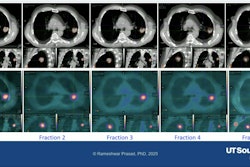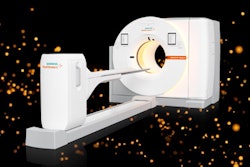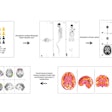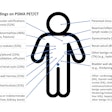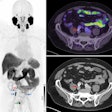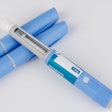NEW ORLEANS – A new radioligand therapy that targets two key cancer markers simultaneously has been shown to be safe and effective in humans, according to a study presented June 22 at the Society of Nuclear Medicine and Molecular Imaging 2025 annual meeting.
In nine patients with advanced adenocarcinomas, including pancreatic, pulmonary, renal, and ovarian cancers, early results show that nearly 90% of treated patients experienced either tumor shrinkage or disease stabilization, noted presenter Jialing Xiang, a doctoral student at Peking Union Medical College Hospital in Beijing, China.
“While most existing therapies target a single molecular biomarker, my colleagues and I explored a dual-targeting strategy to simultaneously engage two tumor-associated markers, with the aim of enhancing tumor uptake and therapeutic efficacy across multiple types of cancer,” Xiang said.
Xiang and colleagues developed the heterodimer FAPI-RGD, which targets both fibroblast activation protein (FAP) and the integrin receptor alpha-v beta-3 (RGD) on cancer cells, with preclinical studies showing enhanced tumor uptake and retention over its monomeric counterparts.
In this study, the group labeled FAPI-RDG with the radiation-emitting isotope lutetium-177 (Lu-177) and tested it in humans for the first time to assess its preliminary safety, biodistribution, and dosimetry in patients.
The researchers first performed gallium-68 (Ga-68) FAPI-RGD-PET/CT scans on the nine patients to confirm tumor uptake. All patients received an injection of Lu-177 DOTA-FAPI-RGD in a dosage of 2.2 GBq (60.2 mCi). They then performed safety tests every two weeks after the first treatment for six to eight weeks, which was defined as a one treatment cycle. After one treatment cycle, patients underwent a second Ga-68 FAPI-RGD PET/CT scan to evaluate the preliminary efficacy of the treatment. A 56-year-old woman with disease progression after surgery received Lu-177 FAPI-RGD at 2.2 GBq/cycle. Baseline Ga-68 FAPI-RGD PET/CT revealed intense Lu-177 FAPI-RGD uptake in most metastatic lesions including lymph node and lung modules (left, arrows and square box). After two treatment cycles, a restaging Ga-68 FAPI-RGD-PET/CT scan revealed a significant reduction in tumor size in most of the metastatic lesions. Furthermore, most of the lesions in the lungs have disappeared (right, arrows and square box).Jialing Xiang and SNMMI
A 56-year-old woman with disease progression after surgery received Lu-177 FAPI-RGD at 2.2 GBq/cycle. Baseline Ga-68 FAPI-RGD PET/CT revealed intense Lu-177 FAPI-RGD uptake in most metastatic lesions including lymph node and lung modules (left, arrows and square box). After two treatment cycles, a restaging Ga-68 FAPI-RGD-PET/CT scan revealed a significant reduction in tumor size in most of the metastatic lesions. Furthermore, most of the lesions in the lungs have disappeared (right, arrows and square box).Jialing Xiang and SNMMI
According to the results, Lu-177 DOTA-FAPI-RGD was well tolerated by all patients, with no noticeable side effects reported. Significant uptake and long tumor retention of Lu-177 FAPI-RGD resulted in high absorbed tumor doses, such as 4.3 Gy/GBq in lung metastases and 4 Gy/GBq in peri-metastases, Xiang reported.
In total, 88.9% of patients responded positively, with their cancer either shrinking or stopping its growth. In addition, many also experienced relief from physical symptoms -- reporting less pain, better appetite, and an overall improvement in quality of life compared with previous treatments, Xiang noted.
“The beauty of this drug is that it stays in tumors for days, allowing prolonged damage to cancer cells," he said. "It offers real hope for patients with advanced cancers who have exhausted other treatment options."
Future prospective trials are planned to optimize dosage for maximum patient benefit, Xiang concluded.







